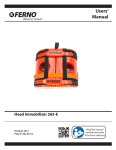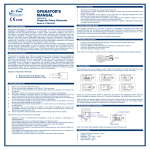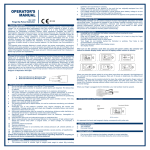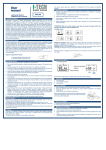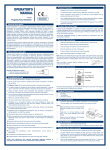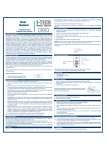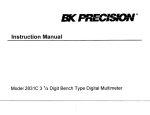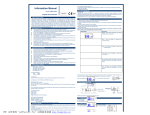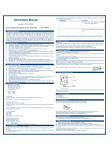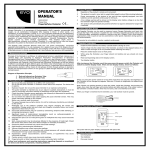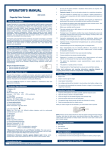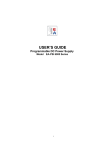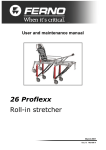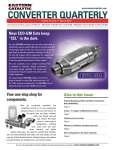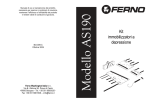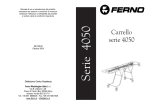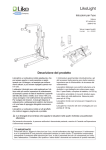Download Instruction Manual 98 77
Transcript
Instruction Manual Finger type Pulse Oximeter No. T10565 1. General Description Hemoglobin Saturation is a percentage of the amount of oxygen combined with hemoglobin in proportion to the amount of oxygen the hemoglobin is capable of carrying. It is expressed as a percentage of a ratio: content/capacity. In other words, it is the existence of oxygen in the blood, which is known as Oxyhemoglobin. It is a very important physiological parameter for Respiratory circulation system. Many respiratory diseases can result in hemoglobin saturation being lowered in human blood. Moreover, the following factors can also lead to problems in oxygen supply, potentially causing human hemoglobin saturation to be reduced: Automatic Organic Regulation Malfunction caused by Anesthesia, Intensive Postoperative Trauma, injuries resulting from medical examinations, etc. or in the situation of illnesses, such as light headedness, asthenia, vomiting, etc., might happen to the patients and possibly endanger the patient’s life. Therefore, it is very important to know the patient’s hemoglobin saturation. The Finger type Pulse Oximeter features, a large display, low power consumption, convenient operation all in a compact portable unit. The patient simply puts one finger into the photoelectric sensor for diagnosis, and the display screen will directly show the measured value of hemoglobin Saturation. 2. Measurement principle Principle of the Oximeter is as follows: An experience formula of data process is established taking use of Lambert Beer Law according to Spectrum Absorption Characteristics of Reductive hemoglobin (R Hb) and Oxyhemoglobin (O2 Hb) in glow and near-infrared zones. The operation principle of the instrument is Photoelectric Oxyhemoglobin inspection technology is adopted in accordance with Capacity Pulse Scanning and Recording Technology, so that two beams of different wavelength of lights (660nm glow and 940nm near infrared light) can be focused onto a human nail tip through perspective clamp finger-type sensor. The measured signal is obtained by a photosensitive element. The information acquired will be shown on two groups of LEDs through a process in the electronic circuits and microprocessor. Diagram of Operation Principle 1. Red and Infrared-ray Emission 2. Red and Infrared-ray Receipt 10. The pulse oximeter has no SpO2 alarms; it is not for continuous monitoring, as indicated by the symbol. 11. Prolonged use or the patient’s condition may require changing the sensor site periodically. Change sensor site and check skin integrity, circulatory status, and correct alignment at least every 4 hours. 12. Inaccurate measurements may be caused by autoclaving, ethylene oxide sterilizing, or immersing the sensors in liquid may cause inaccurate readings. 13. Significant levels of dysfunctional hemoglobin’s (such as carbonxy-hemoglobin or methemoglobin) 14. Intravascular dyes such as indocyanine green or methylene blue. 15. SpO2 measurements may be adversely affected in the presence of high ambient light or direct sunlight. Shield the sensor area from the light source (example: shield with a towel). 16. Excessive patient movement. 17. High-frequency electrosurgical and electromagnetic interference and defibrillators. 18. Venous pulsations 19. Placement of a sensor on an extremity with a blood pressure cuff, arterial catheter, or intravascular line. 20. The patient has hypotension, severe vasoconstriction, severe anemia, or hypothermia. 21. The patient is in cardiac arrest or is in shock 22. Fingernail polish or false fingernails may cause inaccurate SpO2 readings. Follow local ordinances and recycling instructions regarding disposal or recycling of the device and device components, including batteries. After turn on the oximeter, each time you press the power switch, the oximeter will switch to another display mode, there are 6 display modes shown as follows: 1. FERNO2 2. FERNO2 3. FERNO2 4. FERNO2 5. 4. Product Properties 1 Operation of the product is simple and convenient 2 The product is small in volume, light in weight (total weight is about 50g including batteries) and can be conveniently carried. 3 Power consumption of the product is low and the two originally-equipped AAA batteries can be operated continuously for approximately 30 hours. 4 Low voltage warning will be indicated in the visual window when battery voltage is so low that normal operation of the oximeter might be influenced. 5 The product will automatically be powered off when no signal is detected for longer than 8 seconds. 5. Product Operation Scope The finger type Oximeter can be used to measure human Hemoglobin Saturation and heart rate through a finger. The product is suitable for use in family, hospital (including clinical use in internist/ surgery, anesthesia, pediatrics, intensive care, etc.) With medical direction, the unit can be used in sports medicine. The unit can be used before or after sports. Operation in sport procedure is not recommended, etc. The product is not suitable to monitor patient continuously during play or activity. FERNO2 6. FERNO2 When you press the power switch for a long time (more than on second), the brightness of the oximeter will be changed by degrees, there are 10 levels on brightness; the default level is level four. Declaration: Please use the medical alcohol to clean the rubber touching the finger inside of Oximeter, and clean the test finger using alcohol before an after each test. (The rubber inside os the Oximeter belongs medical rubber, which has no toxin, and no harmful to the skin of human being). When the patients finger is inserted into the Oximeter, the fingernail surface must be facing upward. 1 Remove batter cover. Install two AAA batteries into the battery cassette. Replace cover. 2 Patients finger to be monitored should be clean. Use 7. Brief Description of Front Panel medical alcohol to clean the test finger. Medical alcohol can be used to wipe down the rubber pads inside the clamp zone. Clean the unit before and after each use. SPO2 98 3. Nip (squeeze) the clamp as shown in the diagram. PR Bar graph 4. Plug one patient finger into the rubber hole of the PR 77 Oximeter. It is best to fully engage the finger into the Power Switch unit before releasing the clamp. Low power indicator 5 Press the switch button once on front panel. 6 Hold the patient’s finger steady while the unit is taking SpO % PR its reading. Body movement is not recommended 98 77 during operation. FERNO2 7 Read correspondent data from display screen. 8 There are six (6) display modes. PR bpm SpO2% 6. Operation Instructions 1. Device to be used on or by the order of a physician. 2. Before use, carefully read the manual. 3. Follow all local protocols and care provider standards. 4. Do not use the pulse oximeter in an MRI or CT environment. 5. Do not use the pulse oximeter in situations where alarms are required. The device has no alarms. 6. Explosion hazard: Do not use the pulse oximeter in an explosive atmosphere. 7. The pulse oximeter is intended only as an adjunct in patient assessment. It must be used in conjunction with other methods of assessing clinical signs and symptoms. Unit is designed for temporary checking; not permanent attachment. 8. Check the pulse oximeter sensor application site frequently to determine the positioning of the sensor and circulation and skin sensitivity of the patient. 9. Do not use adhesive tape to apply or secure the unit. FERNO2 3. Precautions for use 2 bpm SPO2 waveform The heart rate bar graph display corresponds with pulse rate. 8. Product Accessories 1 One hang lace 2 Two AAA batteries 3 One Instruction manual 9. Battery Installation Remove batter cover. Install two (2) AAA batteries into the battery cassette with the proper polarity alignment. Replace cover horizontally along the arrow shown as below: Notes: Battery polarities must be correctly installed. Otherwise, damage to the device may occur. Install or remove batteries with care, and in the right position, so as to not damage the device. Batteries should be removed from the Oximeter if the unit will not be used for an extended period of time (battery corrosion may occur). 4. Power Requirements: Two AAA 1.5V Alkaline Batteries Power consumption: less than 40mA Low power indication: Battery Life: Two AAA 1.5V, 600mAh alkaline batteries can be continuously operated for approximately 30 hours. 5. Dimension: Length: 58mm (2.28 inches) Width: 32mm (1.25 inches) Height: 34mm (1.33 inches) Weight: 50g / 1.7 oz. (including two AAA batteries) 6. Environment Requirements: Operation Temperature: 5 to 40°C (41 to 104° F) Storage Temperature: -10 to 40°C (14 to 104° F) Ambient Humidity: 15% to 80% in operation 10% to 80% in storage 7. Declaration: EMC of this product complies with IEC60601-1-1-2 standard. 8. Measurement Performance in Weak Filling Condition: required the test equipment (BIO-TEK INDEX Pulse Oximeter tester) the pulse wave is available without failure when the simulation pulse wave amplitude is at 6%. 9. Interference Resistance Capacity aginst Ambient Light: Device work normally when mixed noise produced by BIO-TEK INDEX Pulse Oximeter tester. “Error7” displayed on screen 2. Emission tube damaged. 3. Current control circuit malfunction. 11. Maintenance and Storage 1. Replace the batteries when the low voltage lamp is displayed on the screen. 2. Clean surface of the finger type Oximeter before it is used in diagnosis for patients. 3. Remove the batteries inside the battery cassette if the Oximeter will not be operated for an extended period of time. 4. It is best to store the product in a place where ambient temperatures are –10 to 40°C (14 to 104°F) and humidity is 10% to 80%. 5. It is recommended that the product be kept in a dry environment for storage. A wet and excessive humid environment might affect the units performance, damage the product or effect its useful life. 6. Please follow the local laws and protocols for proper disposable of used batteries. SpO2 or PR can not be displayed normally SpO2 or PR is showed unstably The Pulse Oximeter is intended for use in the electromagnetic environment specified below. The customer of the user of the Pulse Oximeter should assure that it is used in such an environment. Emission test Compliance RF emissions Group 1 CISPR 11 The Oximeter can not be powered on 13. Declaration EMC of this product comply with IEC60601-1-1-2 standards. The materials which the user comes in contact with are not toxic and no adverse effects on tissues. The unit complies with ISO10993-1 -5, -10. 14. Detailed descriptions of product functions 1. Display Type: OLED display 2. SPO2 : Measurement range: 0-100% Accuracy: ±2 on the range of 70% - 100% < 70% no definition 3. Pulse Rate: Measure range: 30 to 235 BPM (Beats Per Minute) Accuracy: ±2 BPM 1.Retry by inserting the finger until fully engaged 2. Patient’s Oxyhemoglobin value is too low to be measured 2. Repeat test method. If problem continues, follow local protocols for patient assessment and treatment. 1. Finger might not be plugged deep enough 1.Retry by inserting the finger until fully engaged 2. Batteries might be installed incorrectly 2. Remove and reinstall the batteries 1 .Low power 2. Receiving tube being shielded or damaged together with broken connector. 3. Mechanical misplace for receive-emissi on tube 4. Amp circuit malfunction. The Pulse Oximeter uses RF energy only for its internal function. Therefore, it’s RF emissions are very low and are not likely to cause any interference in nearby electronic equipment. The Pulse Oximeter is suitable for use in all establishments, including domestic establishments and those directly connected to the public low-voltage power supply network that supplies buildings use for domestic purposes. 17. Symbol Definitions Symbol Definition The equipment type is BF No SpO2 alarm 3. Contact your local service center SpO2% PRbpm Hemoglobin saturation Heart rate (BPM) Low power indication 1. Normal 2. Replace the batteries SN Serial No. (Attached inside of the unit ) Notes: Please remove the battery when product will not be in used for period of time. 2. Power level of batteries is inadequate. “Error3” or “Error4” displayed on screen Class B CISPR 11 Electromagnetic environment-guldance Refer to user manual before application 1. Replace Batteries. 1. The product is automatically powered off when no signal is detected longer than 8 seconds RF emission 2. Try not to move 1. Low or dead batteries. 3. The Oximeter might be damaged Display screen is suddenly off Solution 1. Finger is not plugged in correctly 2. Finger is trembling or patient’s body is in movement status 12. Calibrating the pulse oximeter 1. The functional tester cannot be used to assess the accuracy of the oximeter. 2. Index 2 that is made by Bioteck company is a function tester. Set Tech to 1. R curve to 2, then user can use this particular calibration curve to measure the oximeter. 3. The test methods used to establish the SpO2 accracy is clinical testing. The oximeter used to measure the arterial hemoglobin oxygen saturatin levels and these levels are to be compared to the levels determined from arterial blood sampling with a CO-oximeter. Possible reason 3 Contact your local service center Guidance and manufacture’s declaration electromagnetic emission 15. Possible Problems and Resolutions Problems 2. Contact your local service center 16. Guidance and manufacture’s declaration - electronmagnetic emissions for all Equipmnet and Systems 10. Hang Lace Installations 1. Thread thinner end of the hang lace through the eyelet on end of the unit. 2. Thread thicker end of the lace through the loop of the thread that was just inserted in eyelet. Pull thicker thread firm. Do not over tighten. 1. Change batteries 1. Low power 1. Change battery 2. Contact your local service center 3. Contact your local service center 4. Contact your local service center Mfg. For: Spiracle Technology 16520 Harbor Blvd. #D Fountain Valley, CA 92708 U.S.A. Ph:(714) 418-1091 Fax:(714) 418-1095 www.spiracle.com email:[email protected] EUROPEAN CONTACT: Ferno Washington Italia s.r.l. via Benedetto Zallone n.26 40066, Pieve di Cento (Bo) - Italy P +39 051 6860028 / F +39 051 6861508 NOTIFIED BODY: DET NORSKE VERITAS 0434 Revision: July 2013


